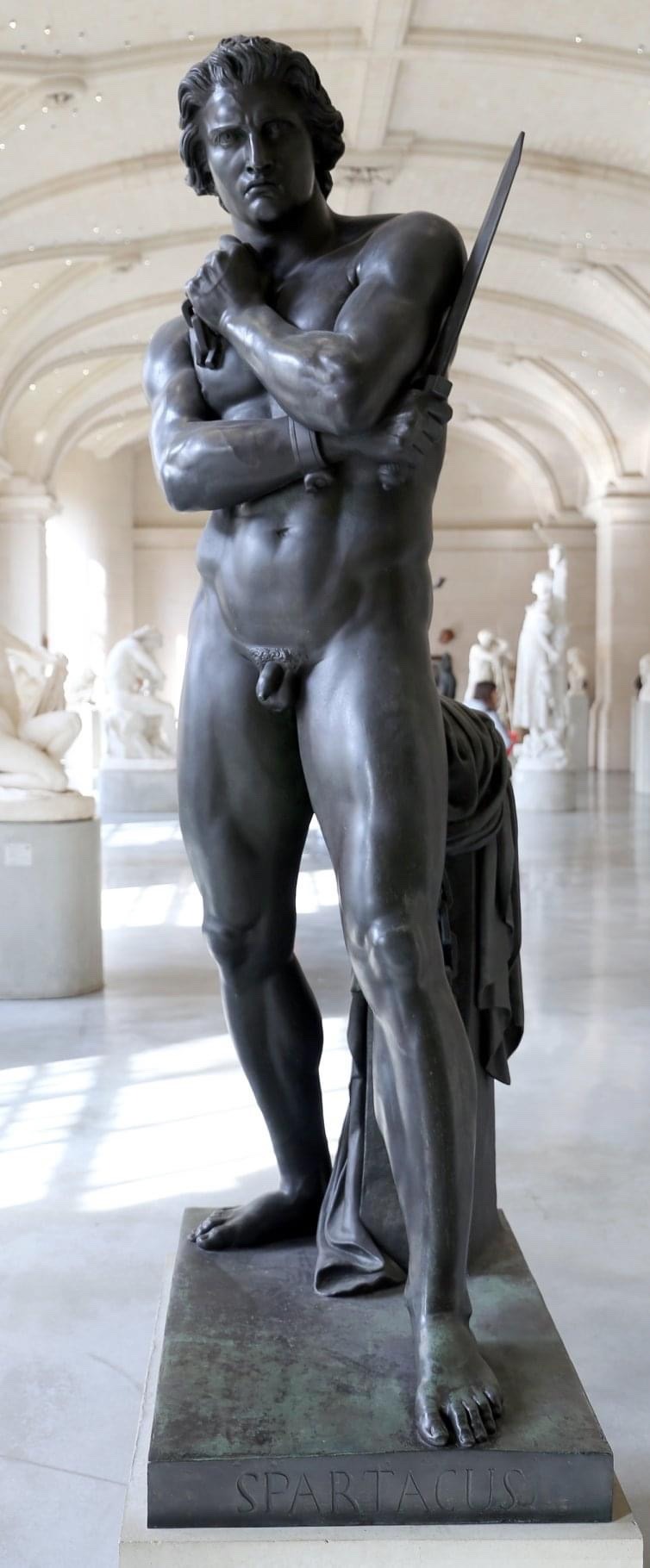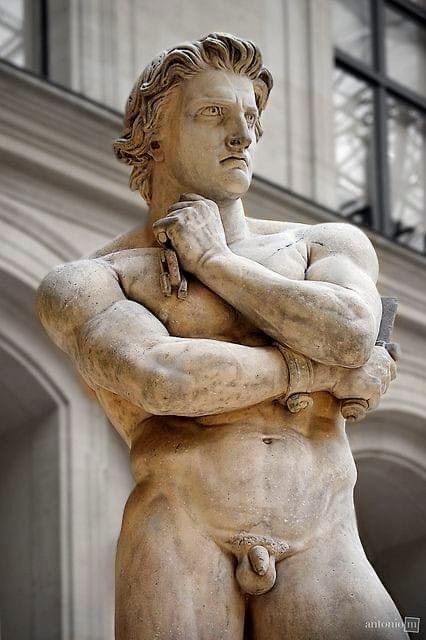#Denis Foyatier
Explore tagged Tumblr posts
Text

Spartacus sculpture en marbre 1830 de Denis Foyatier sculpteur français. Musée du Louvre Paris. source Wikipedia
32 notes
·
View notes
Text
Spartacus Quebrando Suas Correntes (1847)
“Bronze, 219 x 94 x 6 cm”
[Palais des Beaux-Arts de Lille, Lille, França]
Denis Foyatier (Francês; 1793 - 1863)
“Ele nos encara com um olhar severo que é ao mesmo tempo tristemente determinado e furioso. Na mão direita, uma espada. À esquerda, suas correntes quebradas. Spartacus, o soldado do exército romano que se tornou gladiador, acaba de se libertar das correntes e está determinado a lutar.
A vida desta figura histórica é difícil de rastrear. Tudo o que sabemos com certeza é que ele nasceu na Trácia – hoje na Península Balcânica – e que liderou uma revolta de escravos entre 73 e 71 a.C. Esta revolta foi violentamente reprimida pelo general romano Crasso.
Spartacus ainda é visto hoje como o epítome da resistência contra um regime totalitário. Ele é um exemplo de virtude. Não é de surpreender, então, que a escultura tenha sido objeto de exploração política!
Na verdade, aqui você vê um símbolo dos Trois Glorieuses, os três dias da revolução. Esses três dias de revolta, em julho de 1830, levaram à destituição de Carlos X e à ascensão de Luís Filipe. Na verdade sabemos que não era intenção do artista denunciar a realeza, pelo contrário... A versão em mármore de Spartacus, hoje preservada no Louvre, foi encomendada ao artista em 1828 pela administração real de Carlos. A própria história cria seus paradoxos. ”
Spartacus che spezza le sue catene (1847) “Bronzo, 219 x 94 x 6 cm” [Palais des Beaux-Arts de Lille, Lille, Francia] -- Denis Foyatier (Francese; 1793 - 1863)
“Ci fissa, con un aspetto severo, allo stesso tempo tristemente determinato e furioso. Nella mano destra, una spada. A sinistra, le sue catene rotte. Spartaco, il soldato dell'esercito romano diventato un gladiatore, si è appena liberato dai suoi catene ed è determinato a combattere.
La vita di questo personaggio storico è difficile da rintracciare. Tutto quello che sappiamo con certezza è che nacque in Tracia - oggi nella penisola balcanica - e che guidò una rivolta di schiavi tra il 73 e il 71 a.C. Questa rivolta fu repressa violentemente dal generale romano Crasso.
Spartaco è ancora oggi visto come l'epitome della resistenza contro un regime totalitario. Lui è un esempio di virtù. Non sorprende allora che la scultura sia stata oggetto di sfruttamento politico!
In effetti, qui vedete un simbolo dei Trois Glorieuses, i tre giorni di rivoluzione. Questi tre giorni di rivolta, nel luglio 1830, portarono alla rimozione di Carlo X e all'ascesa di Luigi Filippo. Infatti sappiamo che non era intenzione dell'artista denunciare la reale, anzi... La versione marmorea di Spartaco, ora conservata al Louvre, fu commissionata all'artista, nel 1828, dall'amministrazione reale di Carlo X! La storia stessa crea i suoi paradossi. ”

(Fonte: Palais Beaux-Arts Lille)
70 notes
·
View notes
Text



“Spartacus”, 1830 by Denis Foyatier (1793–1863). French sculptor. Musée du Louvre, Paris. marble
291 notes
·
View notes
Text

Spartacus
marble sculpture of Denis Foyatier, 1830 CE. (Louvre Museum, Paris)
7 notes
·
View notes
Text

Sketch commission for @fillipi_arauj0 (Twitter).
Inspired by Denis Foyatier's Spartacus statue.
4 notes
·
View notes
Text
Fate Grand Order Servant Comparisons
Spartacus

Left - FGO
Right - Marble sculpture made by Denis Foyatier (1830)
#fate grand order#fgo#fate apocrypha#spartacus#spartacus fgo#fgo spartacus#spartacus fate#fate spartacus#fate apocrypha spartacus#spartacus fate apocrypha
3 notes
·
View notes
Text



Statue de Jeanne d'Arc, Place du Martroi à Orléans, France, de Denis Foyatier.

Albert Lynch (Peruvian, 1860-1950)
Jeanne d’Arc
15 notes
·
View notes
Photo




Denis FOYATIER (1793 – 1863) - Spartacus, 1827
111 notes
·
View notes
Photo





spartacus (1830)
sculpture by denis foyatier
musée du louvre (paris, france)
23 notes
·
View notes
Photo

Denis Foyatier, Spartacus
50 notes
·
View notes
Text
Sculptural portraits of prince Józef Poniatowski
Good day to you, dear friends, and let me present you the long postponed post about the sculptural portraits of prince Józef.
The most known carving in stone of Poniatowski, is of course, the work of Bertel Thorvaldsen (I will definitely write about it, but later), so no wonder that a lot of sculptures copy it.
This one, for example, stands in The Sukiennice in Kraków:

1. Jakub Tatrkiewicz, Portrait of prince Józef Poniatowski
What’s more - Thorvaldsen himself, during his work on the monument, made several busts of prince:

2. On the left - a plaster-figure from Thorvaldsen museum in Copenhagen. On the right - a bas-relief from the National Museum in Warsaw
Interesting thing - as far as I have found, Thorvaldsen, making the statue of Poniatowski, as a model used a bust of the prince, made by the famous sculptor Vanocci of Carrara. Unfortunately, I didn’t find any photos of images of that bust (and I am not even sure it survived till our days), but there still are some sculptures which might be its copies (or sources).
For example, this one from Stadtgeschichtliches Museum of Leipzig:

3. Franciszek Pinck (prescribed to), a bust of prince Joseph Poniatowskiy
(Pinck died in 1798, so if it’s really his work it must have been created before Thorvaldsen’s monument.)
These two busts from Warsaw also look like copies of Pinck’s creation:

4. On the left - a sculpture from Jabłonna palace, dated as “from the 19th century”; on the right - its modern copy from the Copper-Roofed Palace.
Ok, and are there, you may ask, any other sculptures of prince Józef, not based on Pinck-Thorvaldsen template?
The answer is - yes, they are!
For example, this one, from Galerie des batailles of Versailles:

5. Joseph-Anthony, prince Poniatowski, by François-Augustin Caunois
Or this one, from Warsaw’s Łazienki:

6. Jan Ostrowski, a bust of prince Józef Poniatowski
And this:

7. a bust of prince Poniatowski by an unknown author.
This cameo of Italian origins, from the Metropolitan Museum, is also signed as a depiction of prince Józef:

8. Prince Joseph Antoni Poniatowski, by an unknown author.
Though, in my opinion, the man depicted there looks not like prince Józef, but more like the emperor Napoleon. The third. ))
And as the last one let me show you this pair:

9. On the left - a bust of Józef Poniatowski by the French sculptor Denis Foyatier, on the right - a bust of a man by the same author.
When I spotted the photo of the first one I was really glad, because it seemed to be a kinda proof of the fact, that having shaved his moustache in autumn of 1811 prince Józef didn’t grow it again. But then I stumbled upon the second photo... and it dawned on me, that the first sculpture may be just attributed wrongly.
So, at the end of the post, let me ask you a couple of questions.
What do you think, is it prince Józef on the left photo? And do these two sculptures depict the same man?
Thanks in advance.
#Poniatowski#józef poniatowski#joseph poniatowski#sculpture#thorvaldsen#franciszek pinck#François-Augustin Caunois#jan ostrowski#Denis Foyatier
36 notes
·
View notes
Text
Spartaco,
Denis Foyatier, 1830
Museo del Louvre, Parigi

70 notes
·
View notes
Text


“Spartacus”, c.1830 by Denis Foyatier (1793–1863). French sculptor. Musée du Louvre, Paris. marble
468 notes
·
View notes
Photo

SUNNY SPARTACUS
#SPARTACUS#SUNNY#GIF#ANTIC#LOUVRE#GLADIATOR#ROME#PARODY#KITCH#RED#STATUE#ART#3D#CGI#ARTISTSONTUMBLR#SIRAMADEJUS#ARTISTS ON TUMBLR#denis foyatier
2 notes
·
View notes
Photo

Spartacus. 1830. Denis Foyatier. French 1793-1863. marble. Louvre. http://hadrian6.tumblr.com
1K notes
·
View notes
Photo

Give me your strength Spartacus! #louvre #museedulouvre #foyatier #denis #spartacus #paris #sculpture
2 notes
·
View notes